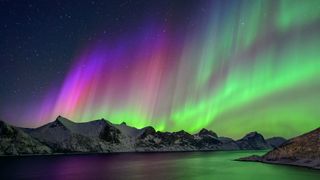A particularly active 'aurora season' could be just weeks away
September could be a prime time to see vibrant auroras, thanks to a quirk of Earth's tilt that leads to more intense geomagnetic activity around the equinox.

In May, the most powerful geomagnetic storm in more than two decades slammed Earth, leading to intense northern lights displays as far south as Florida and Mexico. With solar activity continuing to escalate at record pace, could a similar display be due in September?
There's no guarantee, but there are reasons to believe that the few weeks on either side of this month's fall equinox (Sept. 22) could see geomagnetic storms more intense than usual. It could mean a brief aurora season.
That's because of something called the Russell-McPherron Effect, which explains why the periods around Earth's two equinoxes, in March and September, often tend to have the most colorful auroral displays. A paper published in 1973 argued that auroras consistently appeared more regularly during March and September, thanks to the magnetic fields of Earth and the solar wind being briefly aligned.
The solar wind is a stream of charged particles from the sun, which suddenly intensifies in the wake of solar flares and coronal mass ejections (CMEs) — powerful outbursts of radiation and solar material. Magnetic activity on the sun has a cycle that lasts 11 years. It's due to peak right about now. However, that's not why an aurora season could be imminent.
Auroras occur when charged particles in the solar wind enter Earth's magnetic field and strike oxygen and nitrogen molecules in the atmosphere; this excites the molecules, causing them to emit light in vivid colors.
While Earth's magnetic field and that of the solar wind are usually misaligned, thanks to the Russell-McPherron effect, Earth's magnetic poles are tilted during the equinoxes to receive the charged particles more easily. As south-pointing magnetic fields inside the solar wind cancel out Earth's north-pointing magnetic field, cracks open in Earth's magnetosphere, causing the solar wind to stream along magnetic field lines more easily.
That geometry is well timed for the Northern Hemisphere, for during September's equinox, 12 hours of darkness follow 12 hours of daylight. So, in addition to the greater chance of intense aurora displays, there's also a greater chance of seeing them in a dark sky than we've had all summer.
Get the Space.com Newsletter
Breaking space news, the latest updates on rocket launches, skywatching events and more!
Join our Space Forums to keep talking space on the latest missions, night sky and more! And if you have a news tip, correction or comment, let us know at: community@space.com.

Jamie is an experienced science, technology and travel journalist and stargazer who writes about exploring the night sky, solar and lunar eclipses, moon-gazing, astro-travel, astronomy and space exploration. He is the editor of WhenIsTheNextEclipse.com and author of A Stargazing Program For Beginners, and is a senior contributor at Forbes. His special skill is turning tech-babble into plain English.
